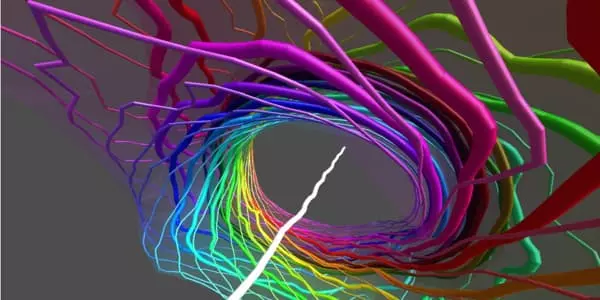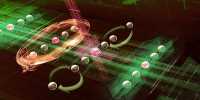Scientists at the University of Birmingham have created an experimental model of an elusive type of fundamental particle known as a skyrmion in a light beam. Skyrmions have the potential to revolutionize computing by exhibiting great potential in electronic information storage, and understanding their behavior under applied currents could be the key to such a breakthrough. Skyrmions are formed in magnetic systems through a variety of mechanisms, some of which interact with one another. The distinct physical properties of these “magic knots” may aid in meeting demand for IT power and storage while using a fraction of the energy.
A skyrmion is the magnetic version of a tornado created by replacing the tornado’s air parcels with magnetic spins and scaling the system down to the nanometre scale. The breakthrough provides physicists with a real system demonstrating the behavior of skyrmions, which were first proposed 60 years ago by Professor Tony Skyrme, a mathematical physicist at the University of Birmingham.
Skyrme’s concept relied on the structure of spheres in four dimensions to ensure the indivisible nature of a skyrmion particle in three dimensions. Theoretically, 3D particle-like skyrmions can tell us about the early origins of the Universe, as well as the physics of exotic materials or cold atoms. Despite being studied for over 50 years, 3D skyrmions have only been seen in a few experiments. The most recent skyrmion research focuses on 2D analogues, which show promise for new technologies.
Skyrmions have long fascinated and perplexed physicists. We live in a 3D world, despite the fact that we’re making good progress investigating skyrmions in 2D. We need a system that can model a skyrmion in all of its possible states in a measurable way.
Professor Mark Dennis
The international collaboration of researchers from the University of Birmingham, Lancaster, Münster (Germany), and RIKEN (Japan) has demonstrated for the first time how skyrmions can be measured in three dimensions in a new study published in Nature Communications.
Professor Mark Dennis, the study’s principal investigator, stated: “Skyrmions have long fascinated and perplexed physicists. We live in a 3D world, despite the fact that we’re making good progress investigating skyrmions in 2D. We need a system that can model a skyrmion in all of its possible states in a measurable way. We realized that a beam of light could be used for this because we can closely control its properties and thus use it as a platform to model our skyrmions. We can begin to truly understand these objects and realize their scientific potential with this approach.”

Dr. Danica Sugic and Professor Dennis from the University’s School of Physics and Astronomy created their model by casting the standard description of light, the polarisation (the direction the light waves travel), and phase (the position of the light waves’ vibration) in terms of a sphere in 4-dimensional space, which was critical to Skyrme’s original vision. In an experiment led by Professor Cornelia Denz of the University of Münster, the Skyrmion field was then designed and engineered into a laser light beam. To determine the precise structure of the skyrmion, the team used cutting-edge measurements.
“From a geometric standpoint, these objects are actually quite intricate,” Dr. Sugic said. “They resemble a complex system of interlocking rings, with the overall structure resembling a particle. The topological properties of the skyrmion are particularly intriguing; they can be distorted, stretched, or squeezed without breaking apart. One of the properties that scientists are most interested in exploiting is this robustness.”
The physicists have chosen to transform the polarization and phase – the wave’s instantaneous position in its cycle – of their light waves in terms of a sphere in four-dimensional space. To capture Tony Skyrme’s idea from nearly 60 years ago. In other words, they created a volumetric light field by superimposing two circularly polarized rays, one on the left and one on the right. They obtained a field of Skyrmions after passing and recombining the beams in a polarized beam splitter (PBS) and a quarter-wave plate after carefully modeling the amplitude and phase beams with a spatial light modulator (SLM) (QWP).
The researchers then used advanced techniques to determine the polarization state and phase of the beam. Polarimetry, interferometry, and digital propagation measurements are used to feed the so-called full-field vector reconstruction (VFFR).













